Recording Business Transactions
VerifiedAdded on 2022/12/29
|14
|2125
|23
AI Summary
This document provides a comprehensive guide on recording business transactions and its significance in evaluating company performance. It covers topics such as T accounts, ledger accounts, trial balance, income statement, financial position, and ratio analysis. The document also includes a comparison of Linda's firm's ratios with industry averages.
Contribute Materials
Your contribution can guide someone’s learning journey. Share your
documents today.
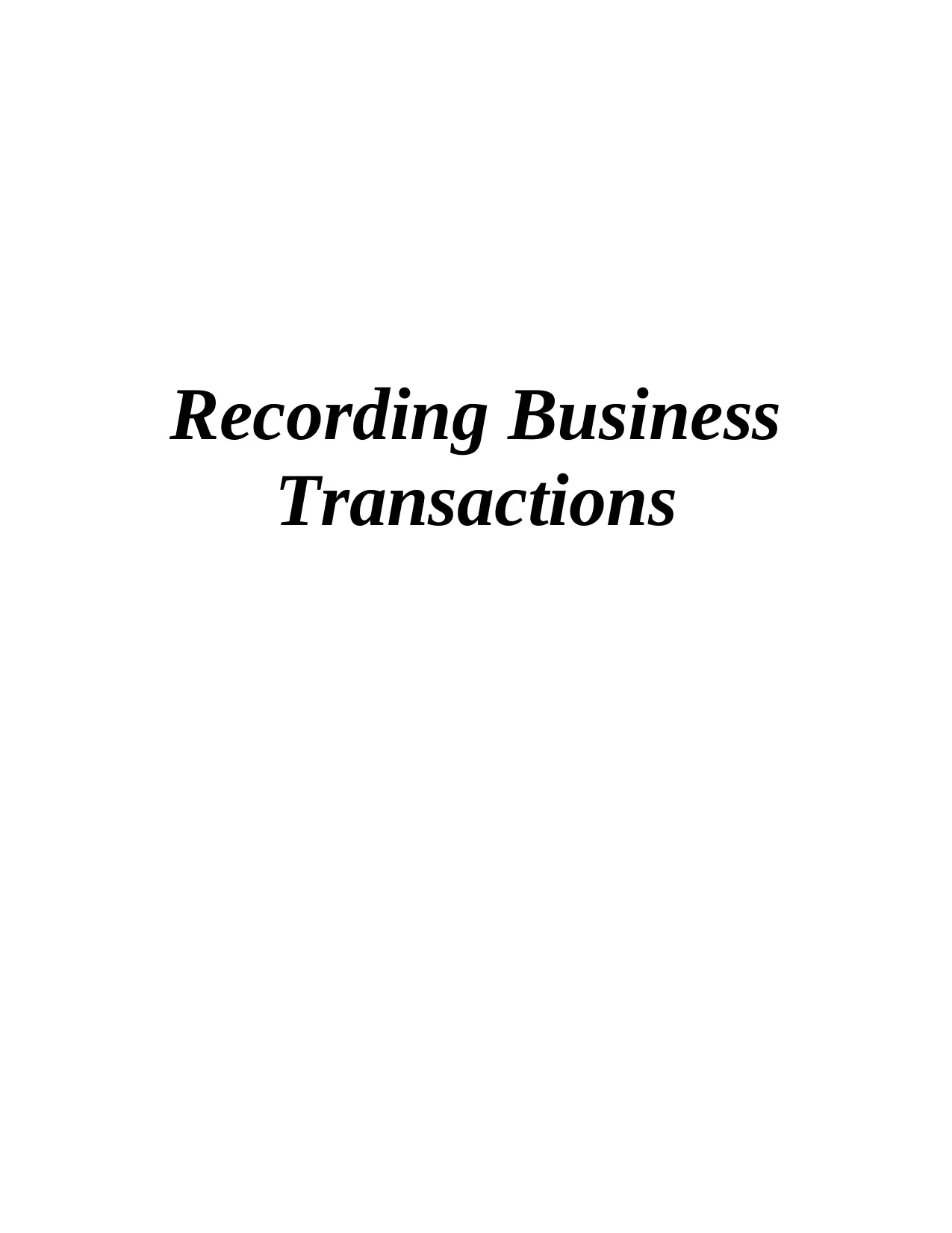
Recording Business
Transactions
Transactions
Secure Best Marks with AI Grader
Need help grading? Try our AI Grader for instant feedback on your assignments.
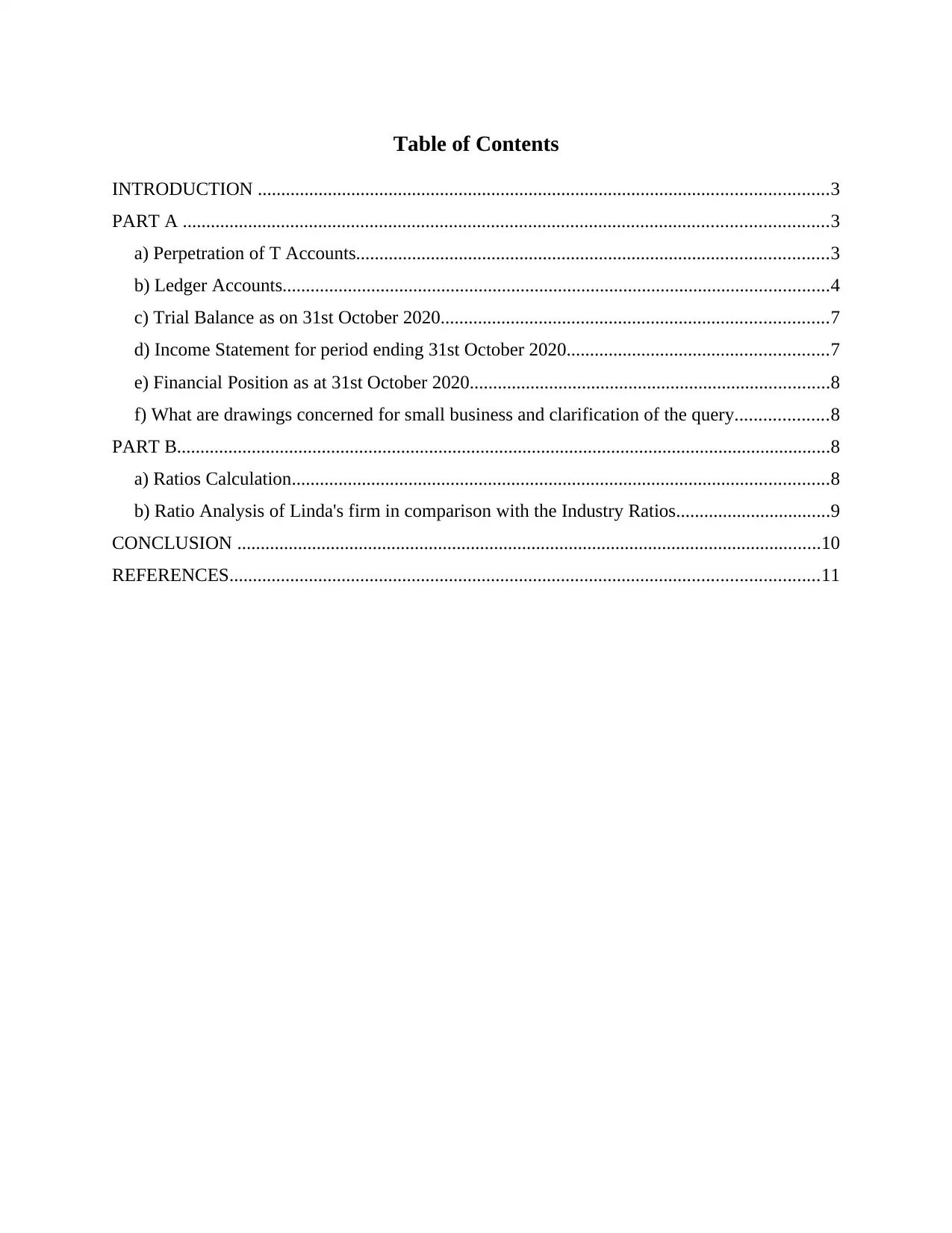
Table of Contents
INTRODUCTION ..........................................................................................................................3
PART A ..........................................................................................................................................3
a) Perpetration of T Accounts.....................................................................................................3
b) Ledger Accounts.....................................................................................................................4
c) Trial Balance as on 31st October 2020...................................................................................7
d) Income Statement for period ending 31st October 2020........................................................7
e) Financial Position as at 31st October 2020.............................................................................8
f) What are drawings concerned for small business and clarification of the query....................8
PART B............................................................................................................................................8
a) Ratios Calculation...................................................................................................................8
b) Ratio Analysis of Linda's firm in comparison with the Industry Ratios.................................9
CONCLUSION .............................................................................................................................10
REFERENCES..............................................................................................................................11
INTRODUCTION ..........................................................................................................................3
PART A ..........................................................................................................................................3
a) Perpetration of T Accounts.....................................................................................................3
b) Ledger Accounts.....................................................................................................................4
c) Trial Balance as on 31st October 2020...................................................................................7
d) Income Statement for period ending 31st October 2020........................................................7
e) Financial Position as at 31st October 2020.............................................................................8
f) What are drawings concerned for small business and clarification of the query....................8
PART B............................................................................................................................................8
a) Ratios Calculation...................................................................................................................8
b) Ratio Analysis of Linda's firm in comparison with the Industry Ratios.................................9
CONCLUSION .............................................................................................................................10
REFERENCES..............................................................................................................................11
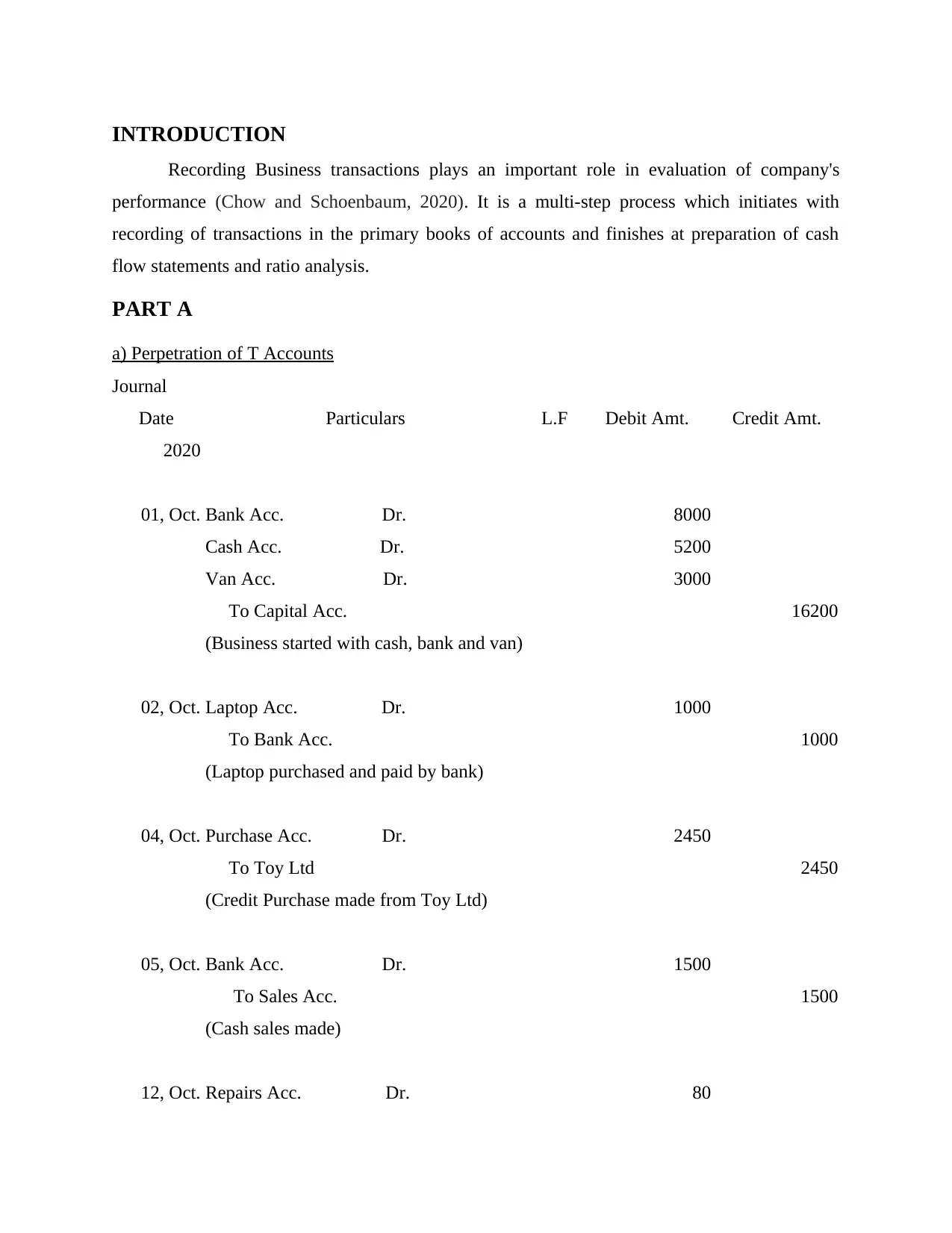
INTRODUCTION
Recording Business transactions plays an important role in evaluation of company's
performance (Chow and Schoenbaum, 2020). It is a multi-step process which initiates with
recording of transactions in the primary books of accounts and finishes at preparation of cash
flow statements and ratio analysis.
PART A
a) Perpetration of T Accounts
Journal
Date Particulars L.F Debit Amt. Credit Amt.
2020
01, Oct. Bank Acc. Dr. 8000
Cash Acc. Dr. 5200
Van Acc. Dr. 3000
To Capital Acc. 16200
(Business started with cash, bank and van)
02, Oct. Laptop Acc. Dr. 1000
To Bank Acc. 1000
(Laptop purchased and paid by bank)
04, Oct. Purchase Acc. Dr. 2450
To Toy Ltd 2450
(Credit Purchase made from Toy Ltd)
05, Oct. Bank Acc. Dr. 1500
To Sales Acc. 1500
(Cash sales made)
12, Oct. Repairs Acc. Dr. 80
Recording Business transactions plays an important role in evaluation of company's
performance (Chow and Schoenbaum, 2020). It is a multi-step process which initiates with
recording of transactions in the primary books of accounts and finishes at preparation of cash
flow statements and ratio analysis.
PART A
a) Perpetration of T Accounts
Journal
Date Particulars L.F Debit Amt. Credit Amt.
2020
01, Oct. Bank Acc. Dr. 8000
Cash Acc. Dr. 5200
Van Acc. Dr. 3000
To Capital Acc. 16200
(Business started with cash, bank and van)
02, Oct. Laptop Acc. Dr. 1000
To Bank Acc. 1000
(Laptop purchased and paid by bank)
04, Oct. Purchase Acc. Dr. 2450
To Toy Ltd 2450
(Credit Purchase made from Toy Ltd)
05, Oct. Bank Acc. Dr. 1500
To Sales Acc. 1500
(Cash sales made)
12, Oct. Repairs Acc. Dr. 80
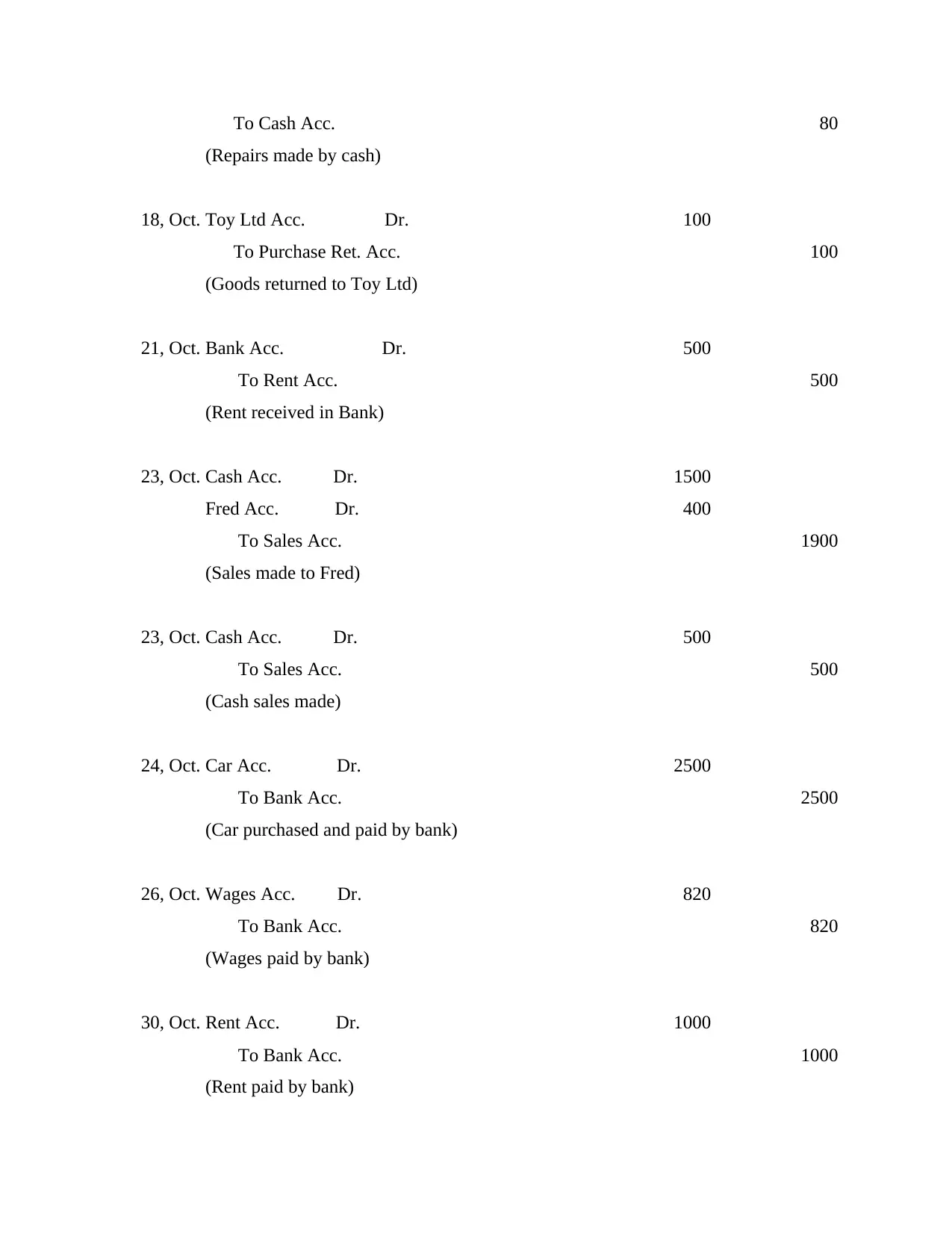
To Cash Acc. 80
(Repairs made by cash)
18, Oct. Toy Ltd Acc. Dr. 100
To Purchase Ret. Acc. 100
(Goods returned to Toy Ltd)
21, Oct. Bank Acc. Dr. 500
To Rent Acc. 500
(Rent received in Bank)
23, Oct. Cash Acc. Dr. 1500
Fred Acc. Dr. 400
To Sales Acc. 1900
(Sales made to Fred)
23, Oct. Cash Acc. Dr. 500
To Sales Acc. 500
(Cash sales made)
24, Oct. Car Acc. Dr. 2500
To Bank Acc. 2500
(Car purchased and paid by bank)
26, Oct. Wages Acc. Dr. 820
To Bank Acc. 820
(Wages paid by bank)
30, Oct. Rent Acc. Dr. 1000
To Bank Acc. 1000
(Rent paid by bank)
(Repairs made by cash)
18, Oct. Toy Ltd Acc. Dr. 100
To Purchase Ret. Acc. 100
(Goods returned to Toy Ltd)
21, Oct. Bank Acc. Dr. 500
To Rent Acc. 500
(Rent received in Bank)
23, Oct. Cash Acc. Dr. 1500
Fred Acc. Dr. 400
To Sales Acc. 1900
(Sales made to Fred)
23, Oct. Cash Acc. Dr. 500
To Sales Acc. 500
(Cash sales made)
24, Oct. Car Acc. Dr. 2500
To Bank Acc. 2500
(Car purchased and paid by bank)
26, Oct. Wages Acc. Dr. 820
To Bank Acc. 820
(Wages paid by bank)
30, Oct. Rent Acc. Dr. 1000
To Bank Acc. 1000
(Rent paid by bank)
Secure Best Marks with AI Grader
Need help grading? Try our AI Grader for instant feedback on your assignments.
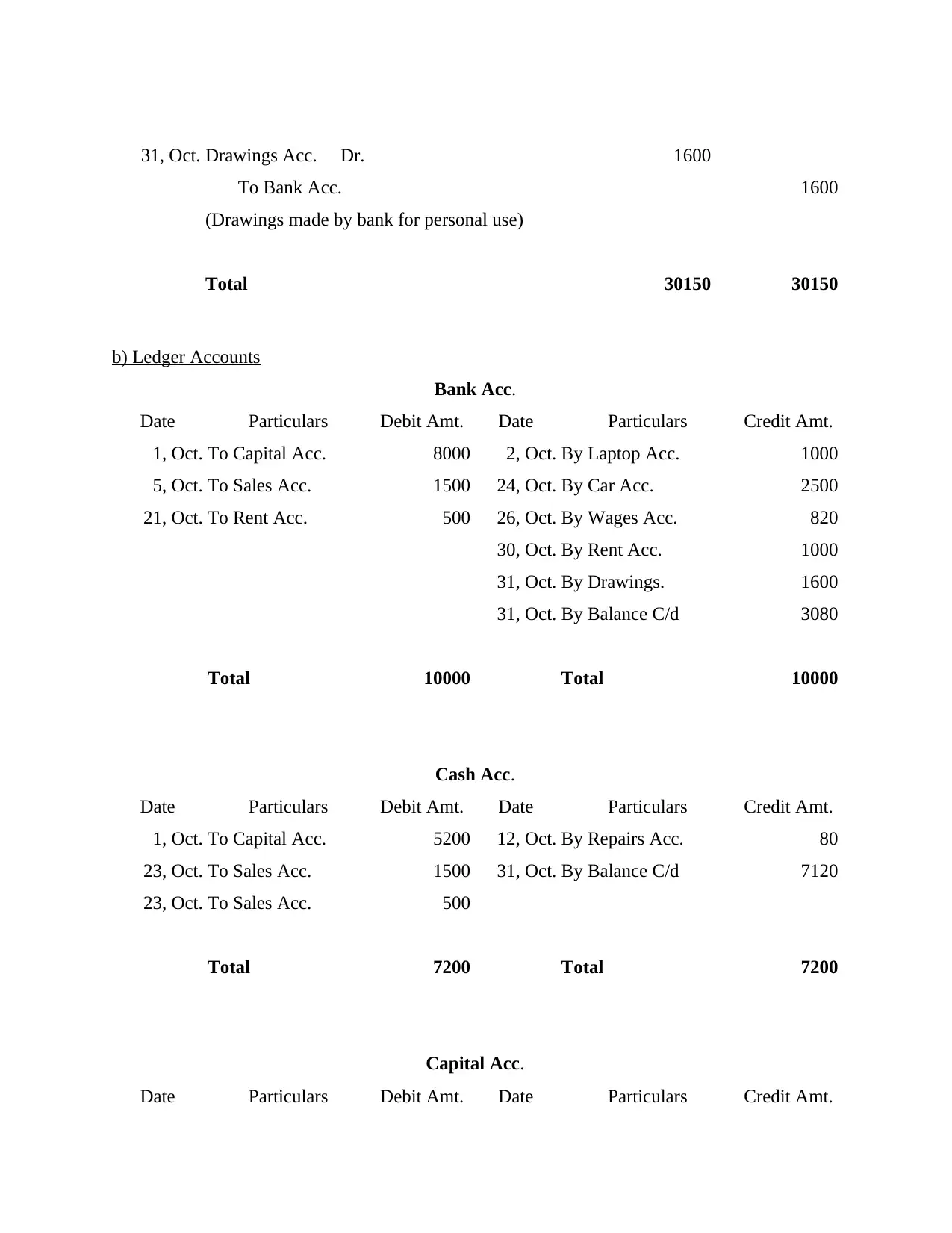
31, Oct. Drawings Acc. Dr. 1600
To Bank Acc. 1600
(Drawings made by bank for personal use)
Total 30150 30150
b) Ledger Accounts
Bank Acc.
Date Particulars Debit Amt. Date Particulars Credit Amt.
1, Oct. To Capital Acc. 8000 2, Oct. By Laptop Acc. 1000
5, Oct. To Sales Acc. 1500 24, Oct. By Car Acc. 2500
21, Oct. To Rent Acc. 500 26, Oct. By Wages Acc. 820
30, Oct. By Rent Acc. 1000
31, Oct. By Drawings. 1600
31, Oct. By Balance C/d 3080
Total 10000 Total 10000
Cash Acc.
Date Particulars Debit Amt. Date Particulars Credit Amt.
1, Oct. To Capital Acc. 5200 12, Oct. By Repairs Acc. 80
23, Oct. To Sales Acc. 1500 31, Oct. By Balance C/d 7120
23, Oct. To Sales Acc. 500
Total 7200 Total 7200
Capital Acc.
Date Particulars Debit Amt. Date Particulars Credit Amt.
To Bank Acc. 1600
(Drawings made by bank for personal use)
Total 30150 30150
b) Ledger Accounts
Bank Acc.
Date Particulars Debit Amt. Date Particulars Credit Amt.
1, Oct. To Capital Acc. 8000 2, Oct. By Laptop Acc. 1000
5, Oct. To Sales Acc. 1500 24, Oct. By Car Acc. 2500
21, Oct. To Rent Acc. 500 26, Oct. By Wages Acc. 820
30, Oct. By Rent Acc. 1000
31, Oct. By Drawings. 1600
31, Oct. By Balance C/d 3080
Total 10000 Total 10000
Cash Acc.
Date Particulars Debit Amt. Date Particulars Credit Amt.
1, Oct. To Capital Acc. 5200 12, Oct. By Repairs Acc. 80
23, Oct. To Sales Acc. 1500 31, Oct. By Balance C/d 7120
23, Oct. To Sales Acc. 500
Total 7200 Total 7200
Capital Acc.
Date Particulars Debit Amt. Date Particulars Credit Amt.
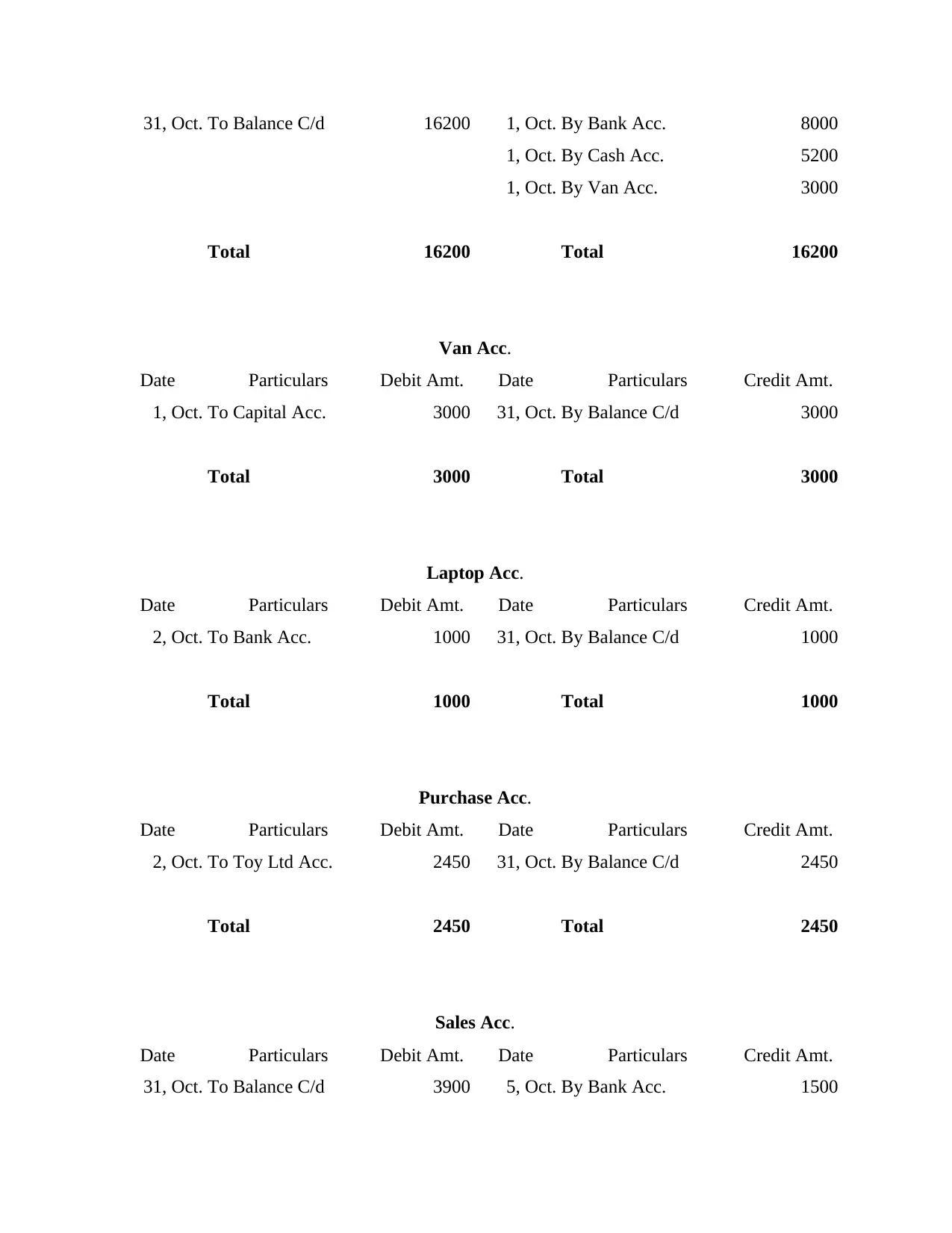
31, Oct. To Balance C/d 16200 1, Oct. By Bank Acc. 8000
1, Oct. By Cash Acc. 5200
1, Oct. By Van Acc. 3000
Total 16200 Total 16200
Van Acc.
Date Particulars Debit Amt. Date Particulars Credit Amt.
1, Oct. To Capital Acc. 3000 31, Oct. By Balance C/d 3000
Total 3000 Total 3000
Laptop Acc.
Date Particulars Debit Amt. Date Particulars Credit Amt.
2, Oct. To Bank Acc. 1000 31, Oct. By Balance C/d 1000
Total 1000 Total 1000
Purchase Acc.
Date Particulars Debit Amt. Date Particulars Credit Amt.
2, Oct. To Toy Ltd Acc. 2450 31, Oct. By Balance C/d 2450
Total 2450 Total 2450
Sales Acc.
Date Particulars Debit Amt. Date Particulars Credit Amt.
31, Oct. To Balance C/d 3900 5, Oct. By Bank Acc. 1500
1, Oct. By Cash Acc. 5200
1, Oct. By Van Acc. 3000
Total 16200 Total 16200
Van Acc.
Date Particulars Debit Amt. Date Particulars Credit Amt.
1, Oct. To Capital Acc. 3000 31, Oct. By Balance C/d 3000
Total 3000 Total 3000
Laptop Acc.
Date Particulars Debit Amt. Date Particulars Credit Amt.
2, Oct. To Bank Acc. 1000 31, Oct. By Balance C/d 1000
Total 1000 Total 1000
Purchase Acc.
Date Particulars Debit Amt. Date Particulars Credit Amt.
2, Oct. To Toy Ltd Acc. 2450 31, Oct. By Balance C/d 2450
Total 2450 Total 2450
Sales Acc.
Date Particulars Debit Amt. Date Particulars Credit Amt.
31, Oct. To Balance C/d 3900 5, Oct. By Bank Acc. 1500
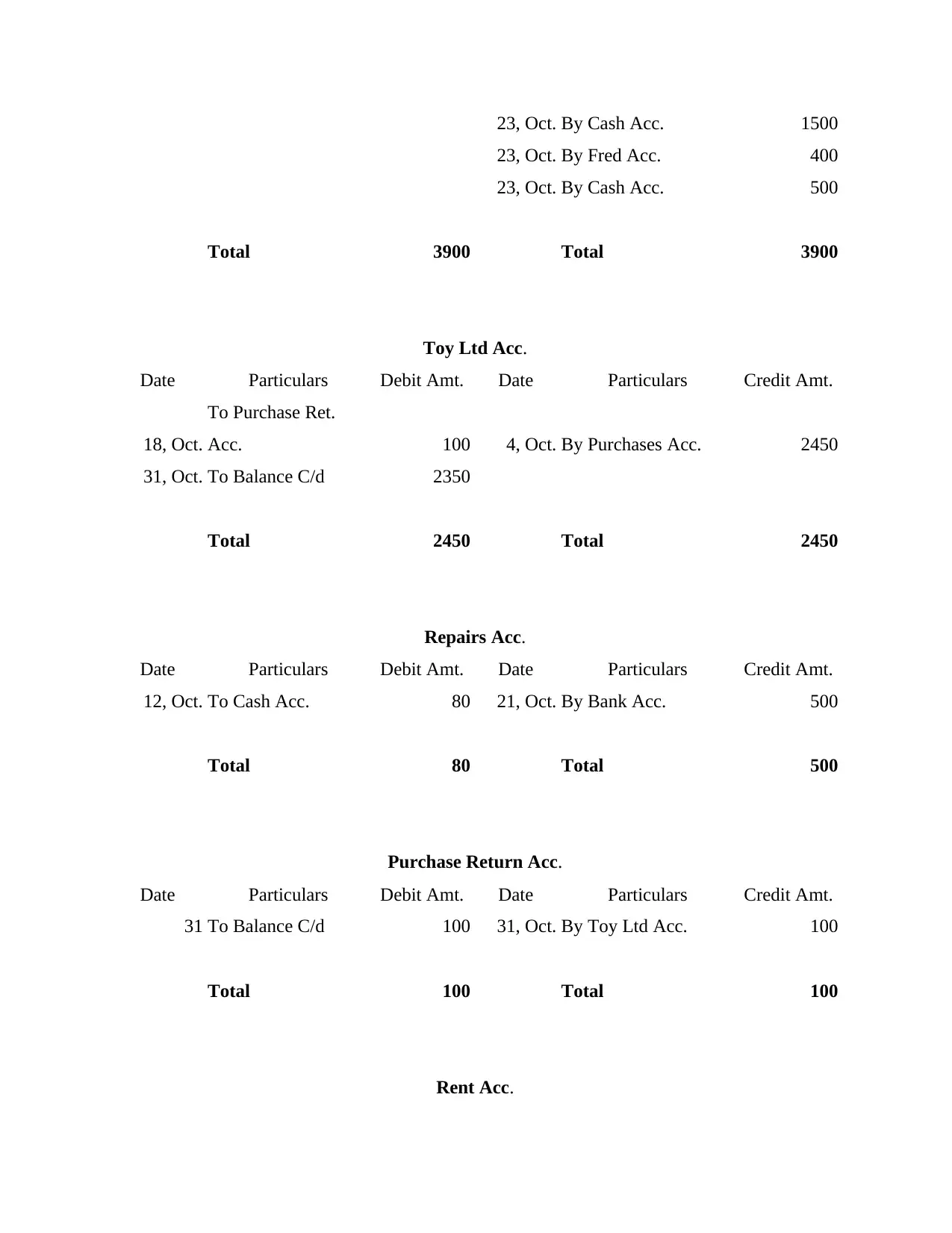
23, Oct. By Cash Acc. 1500
23, Oct. By Fred Acc. 400
23, Oct. By Cash Acc. 500
Total 3900 Total 3900
Toy Ltd Acc.
Date Particulars Debit Amt. Date Particulars Credit Amt.
18, Oct.
To Purchase Ret.
Acc. 100 4, Oct. By Purchases Acc. 2450
31, Oct. To Balance C/d 2350
Total 2450 Total 2450
Repairs Acc.
Date Particulars Debit Amt. Date Particulars Credit Amt.
12, Oct. To Cash Acc. 80 21, Oct. By Bank Acc. 500
Total 80 Total 500
Purchase Return Acc.
Date Particulars Debit Amt. Date Particulars Credit Amt.
31 To Balance C/d 100 31, Oct. By Toy Ltd Acc. 100
Total 100 Total 100
Rent Acc.
23, Oct. By Fred Acc. 400
23, Oct. By Cash Acc. 500
Total 3900 Total 3900
Toy Ltd Acc.
Date Particulars Debit Amt. Date Particulars Credit Amt.
18, Oct.
To Purchase Ret.
Acc. 100 4, Oct. By Purchases Acc. 2450
31, Oct. To Balance C/d 2350
Total 2450 Total 2450
Repairs Acc.
Date Particulars Debit Amt. Date Particulars Credit Amt.
12, Oct. To Cash Acc. 80 21, Oct. By Bank Acc. 500
Total 80 Total 500
Purchase Return Acc.
Date Particulars Debit Amt. Date Particulars Credit Amt.
31 To Balance C/d 100 31, Oct. By Toy Ltd Acc. 100
Total 100 Total 100
Rent Acc.
Paraphrase This Document
Need a fresh take? Get an instant paraphrase of this document with our AI Paraphraser
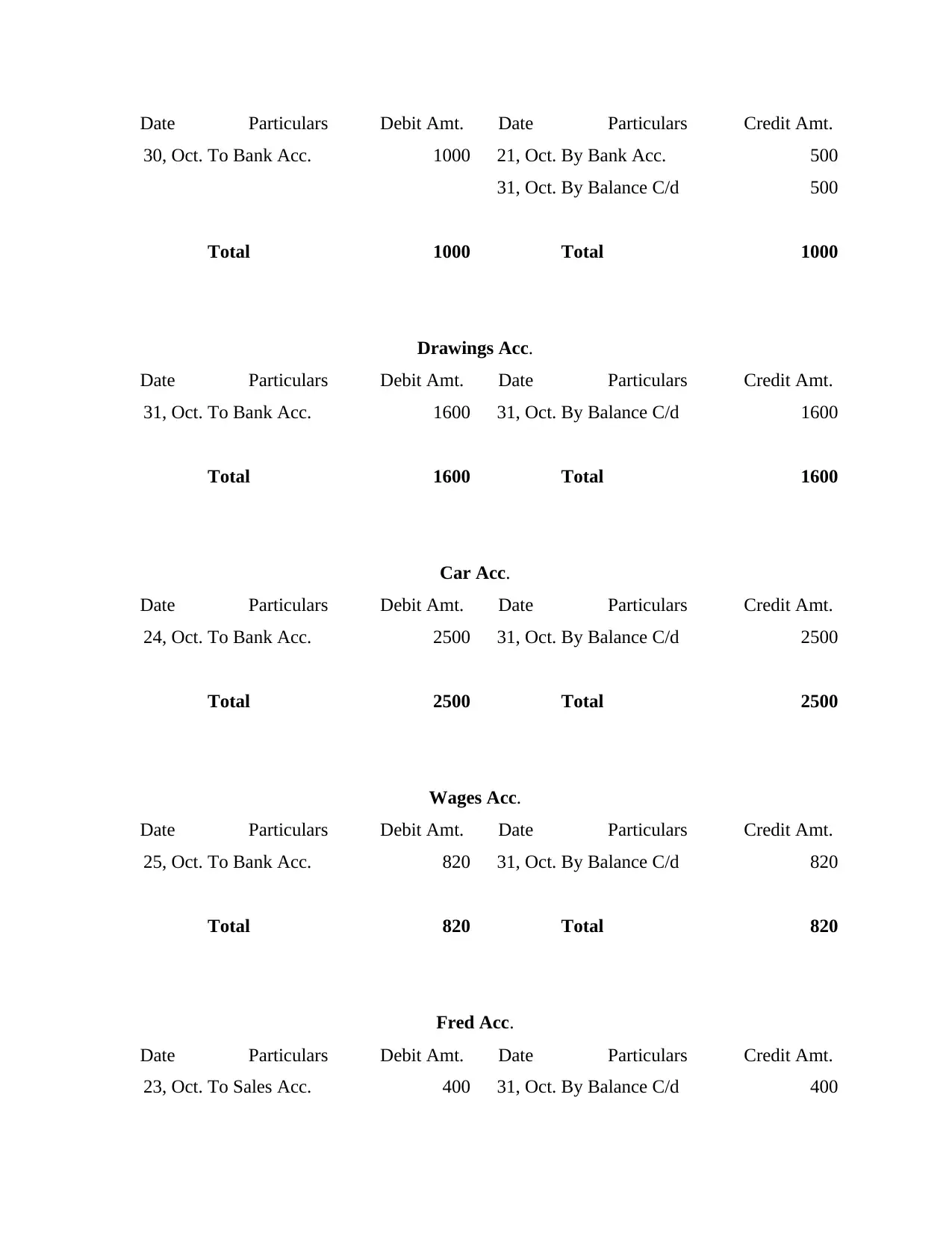
Date Particulars Debit Amt. Date Particulars Credit Amt.
30, Oct. To Bank Acc. 1000 21, Oct. By Bank Acc. 500
31, Oct. By Balance C/d 500
Total 1000 Total 1000
Drawings Acc.
Date Particulars Debit Amt. Date Particulars Credit Amt.
31, Oct. To Bank Acc. 1600 31, Oct. By Balance C/d 1600
Total 1600 Total 1600
Car Acc.
Date Particulars Debit Amt. Date Particulars Credit Amt.
24, Oct. To Bank Acc. 2500 31, Oct. By Balance C/d 2500
Total 2500 Total 2500
Wages Acc.
Date Particulars Debit Amt. Date Particulars Credit Amt.
25, Oct. To Bank Acc. 820 31, Oct. By Balance C/d 820
Total 820 Total 820
Fred Acc.
Date Particulars Debit Amt. Date Particulars Credit Amt.
23, Oct. To Sales Acc. 400 31, Oct. By Balance C/d 400
30, Oct. To Bank Acc. 1000 21, Oct. By Bank Acc. 500
31, Oct. By Balance C/d 500
Total 1000 Total 1000
Drawings Acc.
Date Particulars Debit Amt. Date Particulars Credit Amt.
31, Oct. To Bank Acc. 1600 31, Oct. By Balance C/d 1600
Total 1600 Total 1600
Car Acc.
Date Particulars Debit Amt. Date Particulars Credit Amt.
24, Oct. To Bank Acc. 2500 31, Oct. By Balance C/d 2500
Total 2500 Total 2500
Wages Acc.
Date Particulars Debit Amt. Date Particulars Credit Amt.
25, Oct. To Bank Acc. 820 31, Oct. By Balance C/d 820
Total 820 Total 820
Fred Acc.
Date Particulars Debit Amt. Date Particulars Credit Amt.
23, Oct. To Sales Acc. 400 31, Oct. By Balance C/d 400
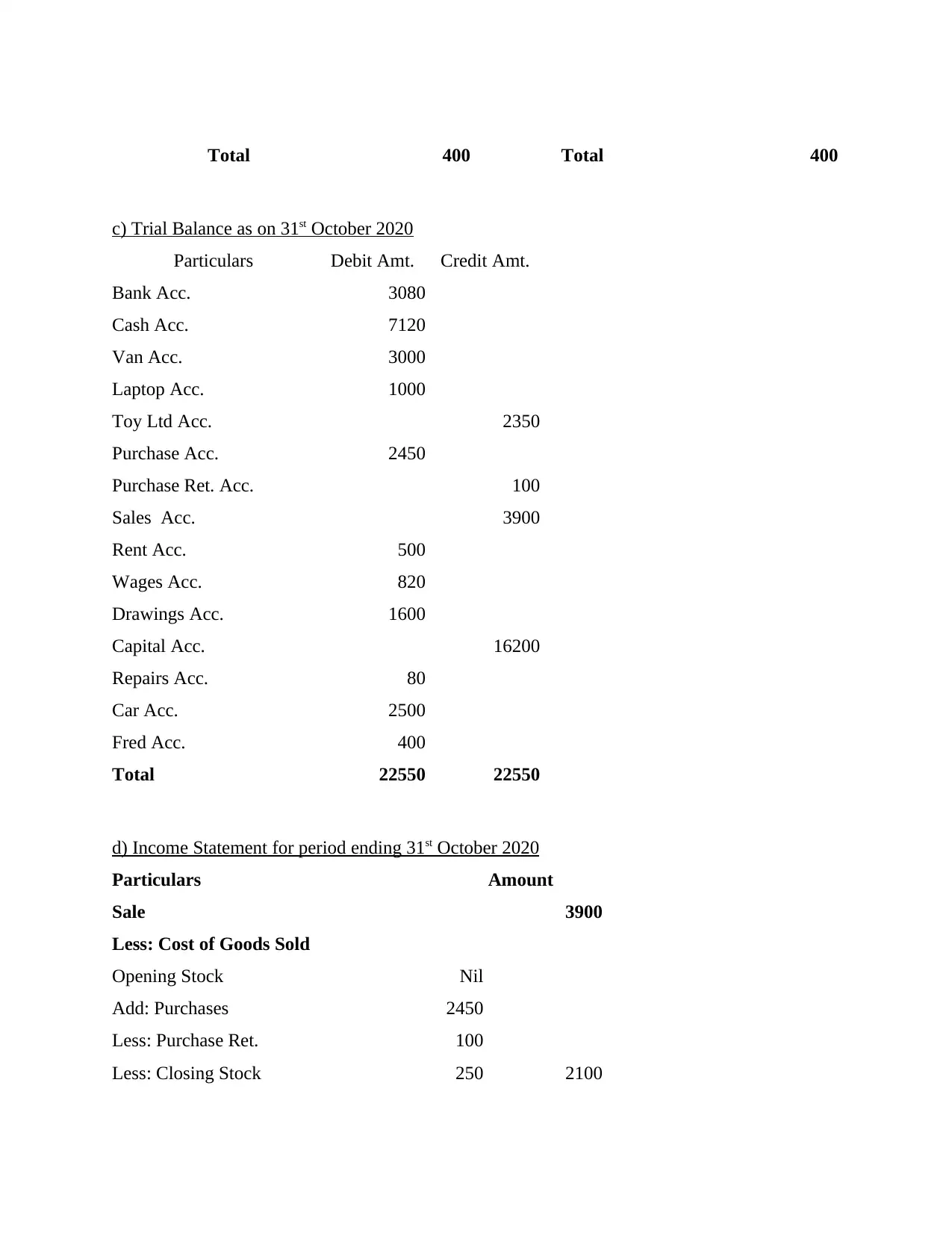
Total 400 Total 400
c) Trial Balance as on 31st October 2020
Particulars Debit Amt. Credit Amt.
Bank Acc. 3080
Cash Acc. 7120
Van Acc. 3000
Laptop Acc. 1000
Toy Ltd Acc. 2350
Purchase Acc. 2450
Purchase Ret. Acc. 100
Sales Acc. 3900
Rent Acc. 500
Wages Acc. 820
Drawings Acc. 1600
Capital Acc. 16200
Repairs Acc. 80
Car Acc. 2500
Fred Acc. 400
Total 22550 22550
d) Income Statement for period ending 31st October 2020
Particulars Amount
Sale 3900
Less: Cost of Goods Sold
Opening Stock Nil
Add: Purchases 2450
Less: Purchase Ret. 100
Less: Closing Stock 250 2100
c) Trial Balance as on 31st October 2020
Particulars Debit Amt. Credit Amt.
Bank Acc. 3080
Cash Acc. 7120
Van Acc. 3000
Laptop Acc. 1000
Toy Ltd Acc. 2350
Purchase Acc. 2450
Purchase Ret. Acc. 100
Sales Acc. 3900
Rent Acc. 500
Wages Acc. 820
Drawings Acc. 1600
Capital Acc. 16200
Repairs Acc. 80
Car Acc. 2500
Fred Acc. 400
Total 22550 22550
d) Income Statement for period ending 31st October 2020
Particulars Amount
Sale 3900
Less: Cost of Goods Sold
Opening Stock Nil
Add: Purchases 2450
Less: Purchase Ret. 100
Less: Closing Stock 250 2100
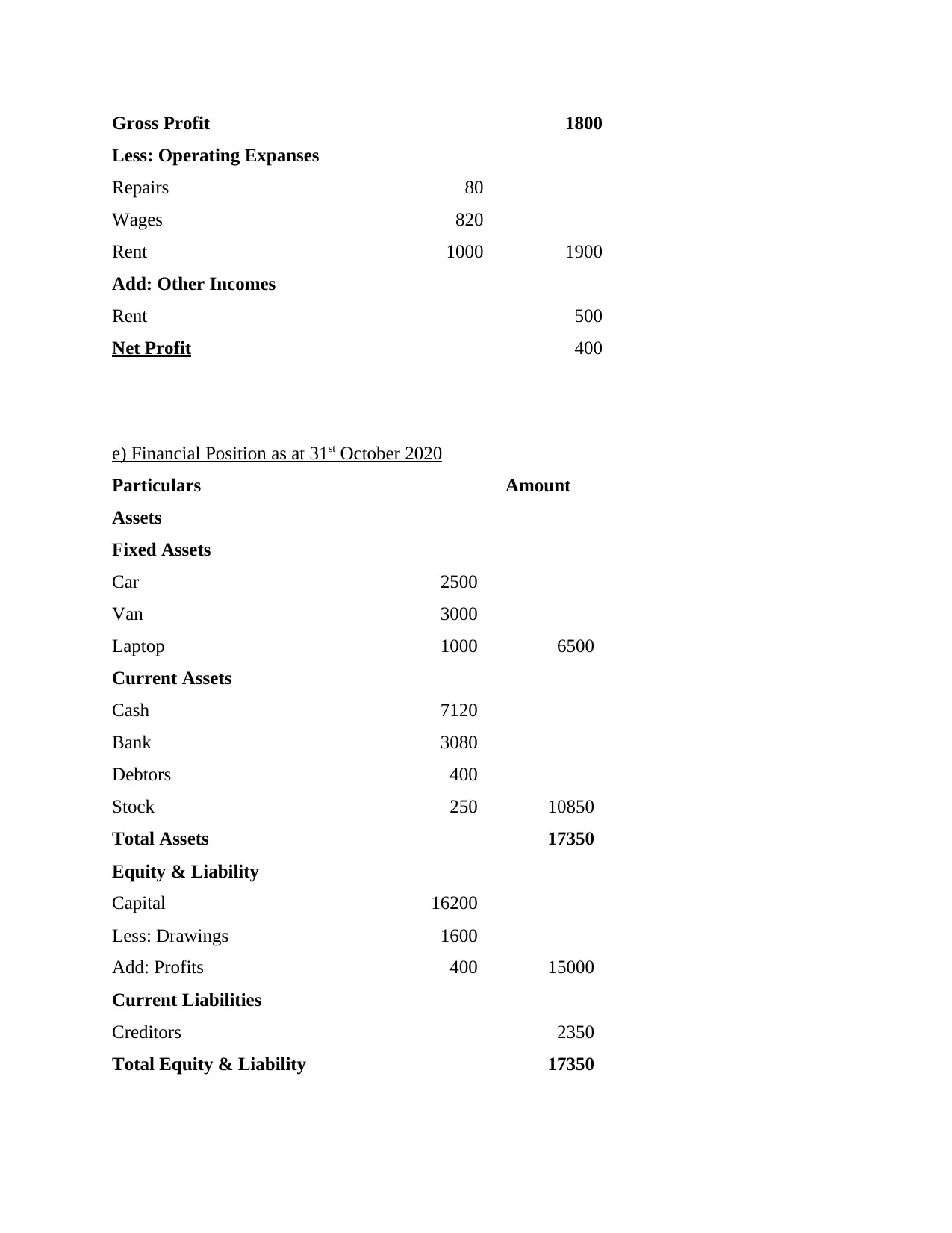
Gross Profit 1800
Less: Operating Expanses
Repairs 80
Wages 820
Rent 1000 1900
Add: Other Incomes
Rent 500
Net Profit 400
e) Financial Position as at 31st October 2020
Particulars Amount
Assets
Fixed Assets
Car 2500
Van 3000
Laptop 1000 6500
Current Assets
Cash 7120
Bank 3080
Debtors 400
Stock 250 10850
Total Assets 17350
Equity & Liability
Capital 16200
Less: Drawings 1600
Add: Profits 400 15000
Current Liabilities
Creditors 2350
Total Equity & Liability 17350
Less: Operating Expanses
Repairs 80
Wages 820
Rent 1000 1900
Add: Other Incomes
Rent 500
Net Profit 400
e) Financial Position as at 31st October 2020
Particulars Amount
Assets
Fixed Assets
Car 2500
Van 3000
Laptop 1000 6500
Current Assets
Cash 7120
Bank 3080
Debtors 400
Stock 250 10850
Total Assets 17350
Equity & Liability
Capital 16200
Less: Drawings 1600
Add: Profits 400 15000
Current Liabilities
Creditors 2350
Total Equity & Liability 17350
Secure Best Marks with AI Grader
Need help grading? Try our AI Grader for instant feedback on your assignments.
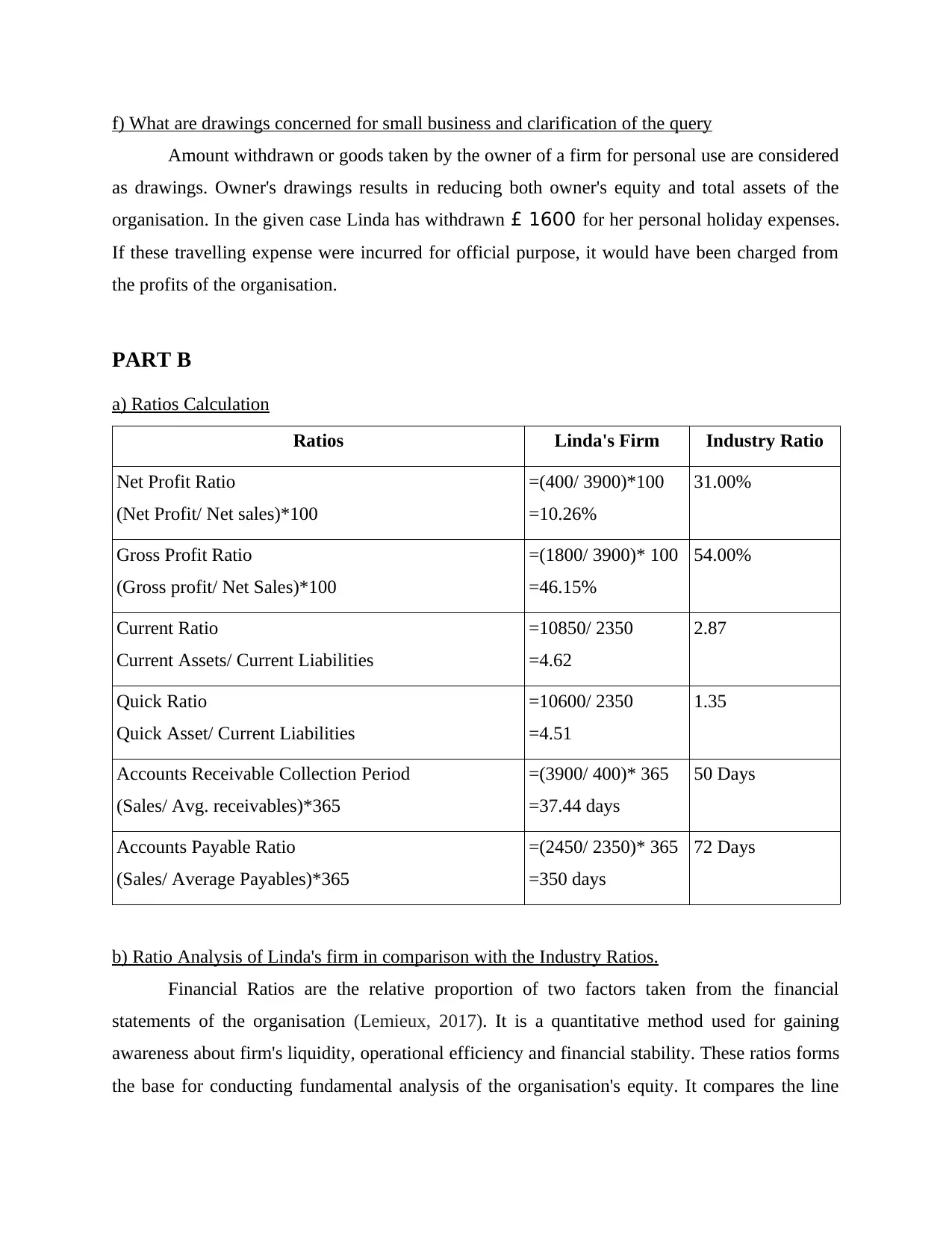
f) What are drawings concerned for small business and clarification of the query
Amount withdrawn or goods taken by the owner of a firm for personal use are considered
as drawings. Owner's drawings results in reducing both owner's equity and total assets of the
organisation. In the given case Linda has withdrawn £ 1600 for her personal holiday expenses.
If these travelling expense were incurred for official purpose, it would have been charged from
the profits of the organisation.
PART B
a) Ratios Calculation
Ratios Linda's Firm Industry Ratio
Net Profit Ratio
(Net Profit/ Net sales)*100
=(400/ 3900)*100
=10.26%
31.00%
Gross Profit Ratio
(Gross profit/ Net Sales)*100
=(1800/ 3900)* 100
=46.15%
54.00%
Current Ratio
Current Assets/ Current Liabilities
=10850/ 2350
=4.62
2.87
Quick Ratio
Quick Asset/ Current Liabilities
=10600/ 2350
=4.51
1.35
Accounts Receivable Collection Period
(Sales/ Avg. receivables)*365
=(3900/ 400)* 365
=37.44 days
50 Days
Accounts Payable Ratio
(Sales/ Average Payables)*365
=(2450/ 2350)* 365
=350 days
72 Days
b) Ratio Analysis of Linda's firm in comparison with the Industry Ratios.
Financial Ratios are the relative proportion of two factors taken from the financial
statements of the organisation (Lemieux, 2017). It is a quantitative method used for gaining
awareness about firm's liquidity, operational efficiency and financial stability. These ratios forms
the base for conducting fundamental analysis of the organisation's equity. It compares the line
Amount withdrawn or goods taken by the owner of a firm for personal use are considered
as drawings. Owner's drawings results in reducing both owner's equity and total assets of the
organisation. In the given case Linda has withdrawn £ 1600 for her personal holiday expenses.
If these travelling expense were incurred for official purpose, it would have been charged from
the profits of the organisation.
PART B
a) Ratios Calculation
Ratios Linda's Firm Industry Ratio
Net Profit Ratio
(Net Profit/ Net sales)*100
=(400/ 3900)*100
=10.26%
31.00%
Gross Profit Ratio
(Gross profit/ Net Sales)*100
=(1800/ 3900)* 100
=46.15%
54.00%
Current Ratio
Current Assets/ Current Liabilities
=10850/ 2350
=4.62
2.87
Quick Ratio
Quick Asset/ Current Liabilities
=10600/ 2350
=4.51
1.35
Accounts Receivable Collection Period
(Sales/ Avg. receivables)*365
=(3900/ 400)* 365
=37.44 days
50 Days
Accounts Payable Ratio
(Sales/ Average Payables)*365
=(2450/ 2350)* 365
=350 days
72 Days
b) Ratio Analysis of Linda's firm in comparison with the Industry Ratios.
Financial Ratios are the relative proportion of two factors taken from the financial
statements of the organisation (Lemieux, 2017). It is a quantitative method used for gaining
awareness about firm's liquidity, operational efficiency and financial stability. These ratios forms
the base for conducting fundamental analysis of the organisation's equity. It compares the line
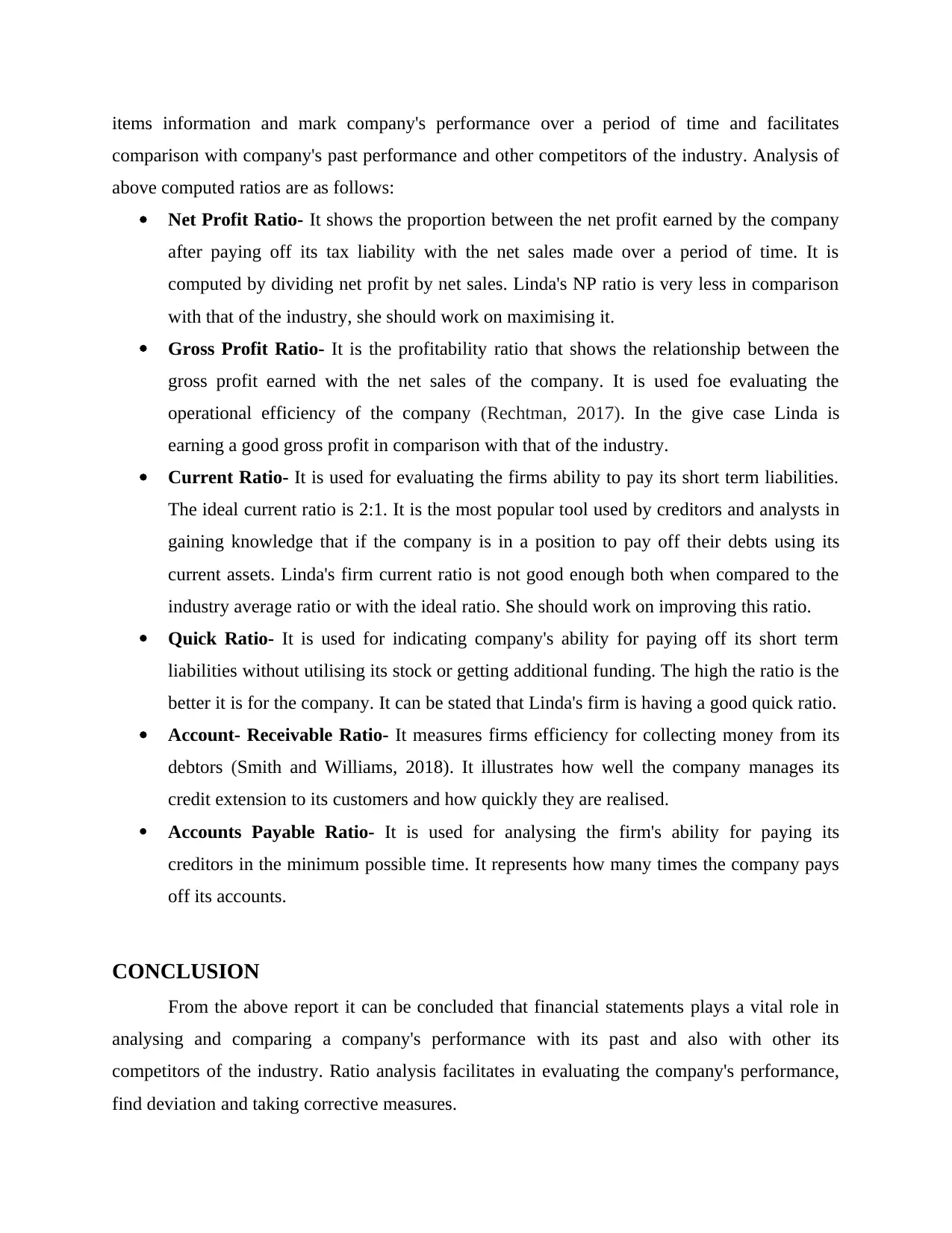
items information and mark company's performance over a period of time and facilitates
comparison with company's past performance and other competitors of the industry. Analysis of
above computed ratios are as follows:
Net Profit Ratio- It shows the proportion between the net profit earned by the company
after paying off its tax liability with the net sales made over a period of time. It is
computed by dividing net profit by net sales. Linda's NP ratio is very less in comparison
with that of the industry, she should work on maximising it.
Gross Profit Ratio- It is the profitability ratio that shows the relationship between the
gross profit earned with the net sales of the company. It is used foe evaluating the
operational efficiency of the company (Rechtman, 2017). In the give case Linda is
earning a good gross profit in comparison with that of the industry.
Current Ratio- It is used for evaluating the firms ability to pay its short term liabilities.
The ideal current ratio is 2:1. It is the most popular tool used by creditors and analysts in
gaining knowledge that if the company is in a position to pay off their debts using its
current assets. Linda's firm current ratio is not good enough both when compared to the
industry average ratio or with the ideal ratio. She should work on improving this ratio.
Quick Ratio- It is used for indicating company's ability for paying off its short term
liabilities without utilising its stock or getting additional funding. The high the ratio is the
better it is for the company. It can be stated that Linda's firm is having a good quick ratio.
Account- Receivable Ratio- It measures firms efficiency for collecting money from its
debtors (Smith and Williams, 2018). It illustrates how well the company manages its
credit extension to its customers and how quickly they are realised.
Accounts Payable Ratio- It is used for analysing the firm's ability for paying its
creditors in the minimum possible time. It represents how many times the company pays
off its accounts.
CONCLUSION
From the above report it can be concluded that financial statements plays a vital role in
analysing and comparing a company's performance with its past and also with other its
competitors of the industry. Ratio analysis facilitates in evaluating the company's performance,
find deviation and taking corrective measures.
comparison with company's past performance and other competitors of the industry. Analysis of
above computed ratios are as follows:
Net Profit Ratio- It shows the proportion between the net profit earned by the company
after paying off its tax liability with the net sales made over a period of time. It is
computed by dividing net profit by net sales. Linda's NP ratio is very less in comparison
with that of the industry, she should work on maximising it.
Gross Profit Ratio- It is the profitability ratio that shows the relationship between the
gross profit earned with the net sales of the company. It is used foe evaluating the
operational efficiency of the company (Rechtman, 2017). In the give case Linda is
earning a good gross profit in comparison with that of the industry.
Current Ratio- It is used for evaluating the firms ability to pay its short term liabilities.
The ideal current ratio is 2:1. It is the most popular tool used by creditors and analysts in
gaining knowledge that if the company is in a position to pay off their debts using its
current assets. Linda's firm current ratio is not good enough both when compared to the
industry average ratio or with the ideal ratio. She should work on improving this ratio.
Quick Ratio- It is used for indicating company's ability for paying off its short term
liabilities without utilising its stock or getting additional funding. The high the ratio is the
better it is for the company. It can be stated that Linda's firm is having a good quick ratio.
Account- Receivable Ratio- It measures firms efficiency for collecting money from its
debtors (Smith and Williams, 2018). It illustrates how well the company manages its
credit extension to its customers and how quickly they are realised.
Accounts Payable Ratio- It is used for analysing the firm's ability for paying its
creditors in the minimum possible time. It represents how many times the company pays
off its accounts.
CONCLUSION
From the above report it can be concluded that financial statements plays a vital role in
analysing and comparing a company's performance with its past and also with other its
competitors of the industry. Ratio analysis facilitates in evaluating the company's performance,
find deviation and taking corrective measures.

Paraphrase This Document
Need a fresh take? Get an instant paraphrase of this document with our AI Paraphraser
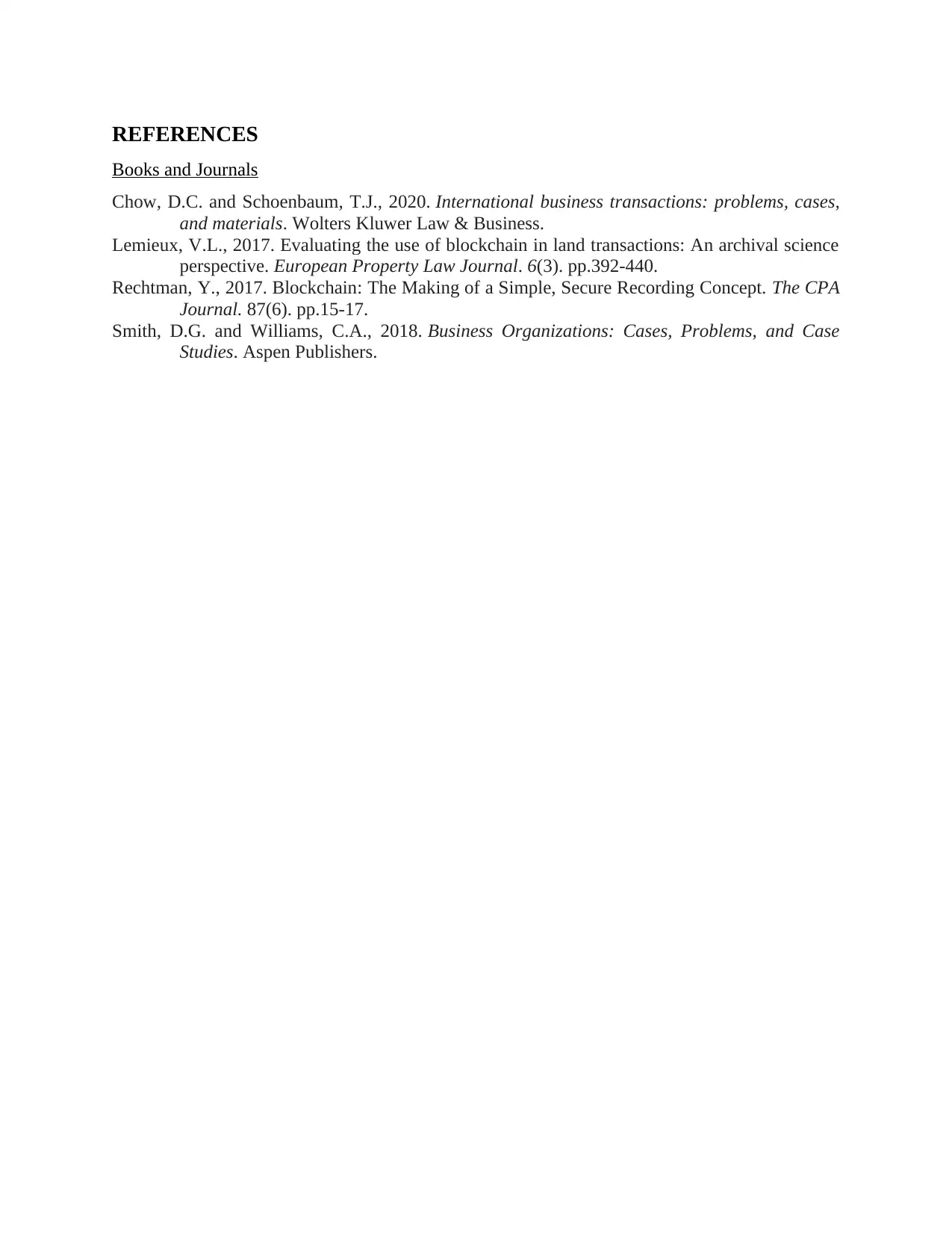
REFERENCES
Books and Journals
Chow, D.C. and Schoenbaum, T.J., 2020. International business transactions: problems, cases,
and materials. Wolters Kluwer Law & Business.
Lemieux, V.L., 2017. Evaluating the use of blockchain in land transactions: An archival science
perspective. European Property Law Journal. 6(3). pp.392-440.
Rechtman, Y., 2017. Blockchain: The Making of a Simple, Secure Recording Concept. The CPA
Journal. 87(6). pp.15-17.
Smith, D.G. and Williams, C.A., 2018. Business Organizations: Cases, Problems, and Case
Studies. Aspen Publishers.
Books and Journals
Chow, D.C. and Schoenbaum, T.J., 2020. International business transactions: problems, cases,
and materials. Wolters Kluwer Law & Business.
Lemieux, V.L., 2017. Evaluating the use of blockchain in land transactions: An archival science
perspective. European Property Law Journal. 6(3). pp.392-440.
Rechtman, Y., 2017. Blockchain: The Making of a Simple, Secure Recording Concept. The CPA
Journal. 87(6). pp.15-17.
Smith, D.G. and Williams, C.A., 2018. Business Organizations: Cases, Problems, and Case
Studies. Aspen Publishers.
1 out of 14
Related Documents
Your All-in-One AI-Powered Toolkit for Academic Success.
+13062052269
info@desklib.com
Available 24*7 on WhatsApp / Email
![[object Object]](/_next/static/media/star-bottom.7253800d.svg)
Unlock your academic potential
© 2024 | Zucol Services PVT LTD | All rights reserved.





